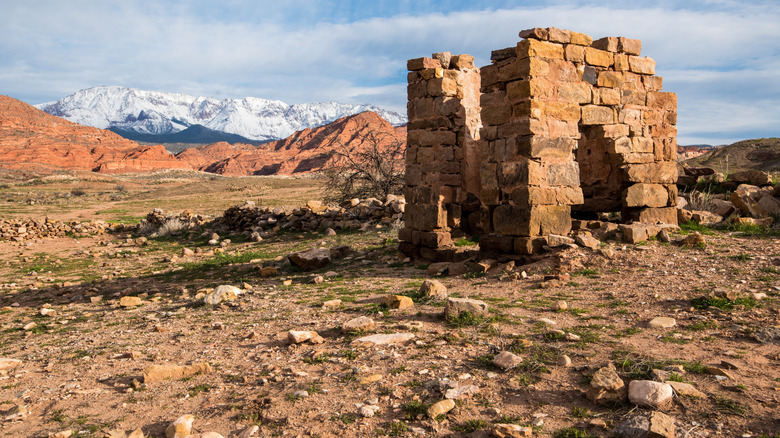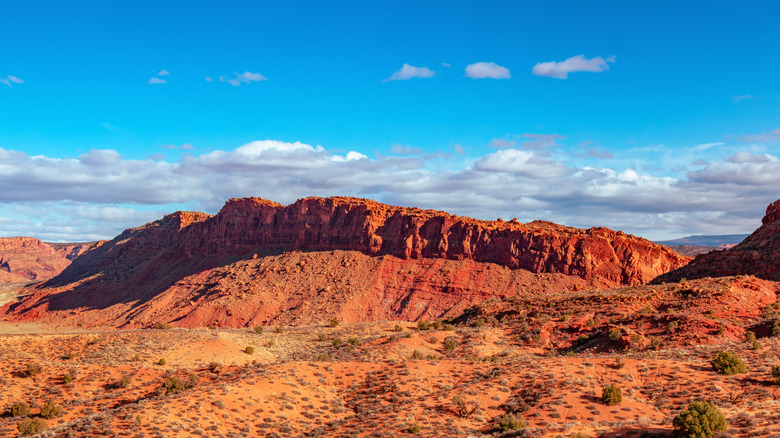Two Hours Outside Of Las Vegas Is Utah's Historic Ghost Town Hidden In The Mountains Near Red Rock Beauty
Located about 130 miles from the wildly popular destination of Las Vegas, Harrisburg is what remains of a once-thriving community. Nestled in the mountains in Washington County, Utah, and surrounded by the vivid red rocks of the Red Cliffs National Conservation Area, the village is now a ghost town, with only stone houses and walls, silent reminders of an ephemeral prosperity. Founded in 1861 under the name Harrisville by a first group of settlers belonging to the Moses Harris family and some Mormon immigrants, their first village unfortunately lacked fertile soil and suitable farmland. In 1862, an unexpected flood submerged the territory, causing the inhabitants to relocate elsewhere along the Quail Creek and name the new town Harrisburg. Until 1869, the residents lived a humble life in stone cottages, but their utopia came to an end after multiple crises mounting over timer — a grasshopper plague, a flooding, and tensions with Native American people trying to defend their own land — eventually forced them to leave again. By 1895, Harrisburg was officially a ghost town.
The arid, desolate landscape welcomes visitors year-round. Despite not having much left to show, some stone offcuts and the Adams House still offer a glimpse into what life could have been. Built between 1862 and 1865, the Adams House is a restored stone mansion named after Orson B. Adams, which stands now as the only testament to a Mormon settlement. Though Harrisburg may not compete with one of America's best-preserved ghost towns in Nevada, or Arizona's once-thriving longest working mining district, the area is still worth exploring. Copper-hued, arid ground scattered with sturdy vegetation spans a mountainous tapestry on the horizon. In the distance, the Pine Valley Mountains tower over visitors, spanning 120 square miles with their highest peak being Signal Peak (10,371 feet). Spruce, fir trees, bitter cherry, and common sandweed dot the valley, making it one of the most biologically diverse territories.
Visiting the Red Cliffs National Conservation Area
Harrisburg's ghost town is traversed by Interstate 15, so if you're driving along that route, pull over, explore the historic site, and immerse yourself in the untamed beauty of the Red Cliffs National Conservation Area, where majestic red-colored cliffs stand tall hugging the significant old village that awaits your arrival. At the intersection of Mojave Desert, Colorado Plateau, and Great Basin territory, lies a 46,500-acre biodiverse landscape that has become a vital haven for local fauna such as the Mojave Desert tortoise, along with aquatic life inhabiting its fresh rivers.
The natural area is well known for its canyons and geological formations. Cottonwood Canyon is an example of a canyon carved into rock from the Navajo Sandstone, a cross-bedded sandstone formation that dates back to the Early Jurassic. You may be curious to know that the Red Cliffs National Conservation Area is home to 11 mountains, with the highest summit being Twin Peaks, rising 5,354 feet above sea level. If you're feeling adventurous and yearning for an Indiana Jones-style day out, hiking is a popular activity, where several trails allow you to make your way through the rocky scenery. The Red Reef Trail starts at the Red Reef Trailhead and offers breathtaking views of the canyon as you walk along the river and slowly inch forward into the Cottonwood Canyon Wilderness. The Elephant Arch Trail takes less than an hour and a half to complete and is an easy hike across sandy and rocky landscapes, guiding you toward a rock formation reminiscent of an elephant's head. Owen's Loop Trail is a moderately challenging, underrated hike that offers a view of the town of St. George underneath as you walk on top of red crags. You can conclude the loop in just over an hour.
Living your Jurassic Park moment
If you ever hoped you'd be able to have a close encounter with a dinosaur fossil, a trip to Harrisburg and the surrounding areas may help that happen. Besides Utah's mountain range full of dinosaur fossils, the Red Cliffs National Conservation Area was once home to colossal dinosaurs that inhabited our Earth. Well-preserved fossils, bone beds, fossilized plants, and 17 tracks act as a testament to these prehistoric animals and help paleontologists dig deeper into a life that happened nearly 200 million of years ago. Even though scientists can't clearly identify which dinosaur the trace fossils belong to, they have associated their discoveries with three dinosaur groups: Grallator, Eubrontes, and Kayentapus.
Walk along the Silver Reef Trail and the Red Reef East Trail to see it with your own eyes. The Silver Reef Trail is a moderate, single-track hike that stretches for less than a mile. The walk takes up to 45 minutes to complete, and kids are welcome to join. Together, you can seize the chance to spot the dinosaur tracks on the rocks. Starting from the Red Cliff Campground, you'll embark on the Red Reef East Trail. It's a moderate, one-way trail that can also be explored on a saddle and on horseback, allowing you to admire traces that date back to the Jurassic Age.
Want to spend a couple of nights away from streetlights and noise? The Red Cliffs Recreation Area, within the Red Cliffs National Conservation Area, offers 11 campgrounds open throughout the year. You are welcome to camp for a maximum of 14 days and required to book in advance through their website, paying a booking fee. The cost is $15 per night. The simplest way to reach Harrisburg is by driving about 20 minutes from St. George, and for those flying in, Harrisburg has a regional airport.


